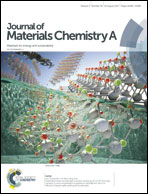Topochemical transformation of two-dimensional single crystalline Na0.5Bi0.5TiO3–BaTiO3 platelets from Na0.5Bi4.5Ti4O15 precursors and their piezoelectricity
Abstract
Two-dimensional monocrystalline platelets of the perovskite structured lead–free system (Na0.5Bi0.5)0.93Ba0.07TiO3 (NBBT) were synthesized from platelets of layer-structured Na0.5Bi4.5Ti4O15 (NBIT), using a topochemical route. Both NBIT and NBBT platelets showed high aspect ratios with an average size of 10 μm and thickness of 0.6 μm, for the latter. A structural transformation from layer-structured NBIT to perovskite NBBT was identified in a transitional platelet, which contained phases of both NBIT and NBBT. The composition of NBBT lies at a morphotropic phase boundary (MPB), with the coexistence of monoclinic and tetragonal polymorphs confirmed by X-ray powder diffraction analysis. Transmission electron microscopy and piezoresponse force microscopy were used to investigate the domain structure, with stripe-like domains in the unpoled system transformed into lamellar domains after poling. The piezoresponse amplitude for a NBBT platelet indicated a large piezoresponse strain, corresponding to a field-induced strain Smax/Emax of around 800 pm V−1 at 5 kV mm−1, which is significantly higher than that in ceramic samples of NBBT at the same applied potential.



 Please wait while we load your content...
Please wait while we load your content...